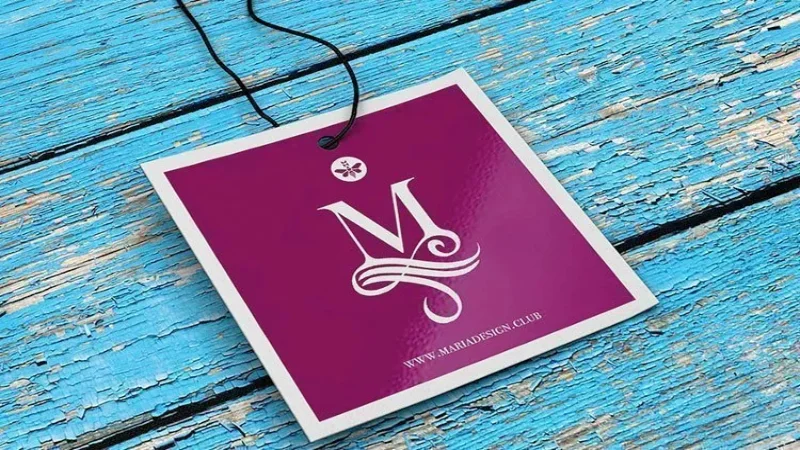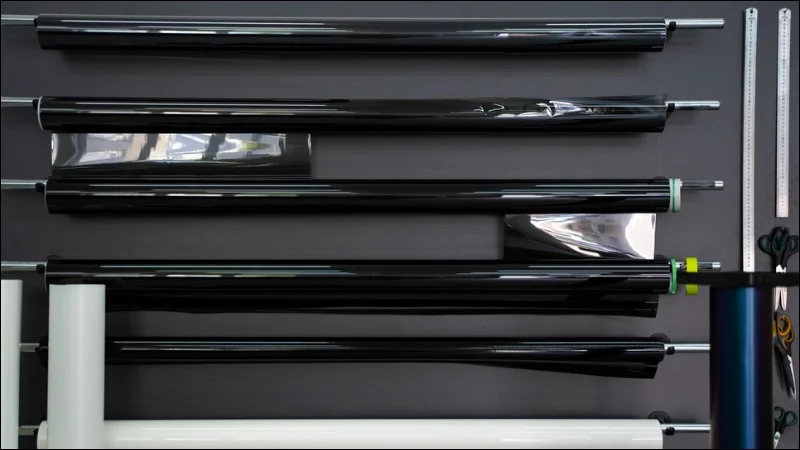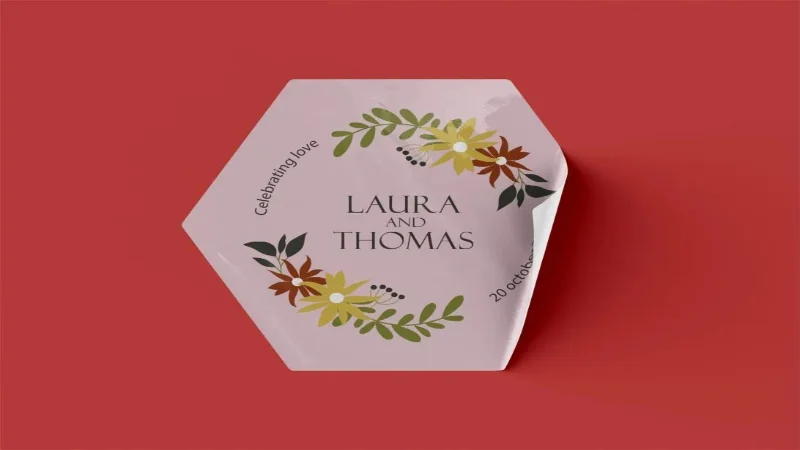Gloss Lamination: Durable, Shiny Finish for Apparel Tags
Choosing the right finish for your brand’s hang tags and labels can seem like a small detail, but for apparel brands, these elements significantly influence customer perception and product longevity. We’ll explore its pros and cons, compare it visually to a matte finish, and help you decide if this shiny, protective coating aligns with your apparel brand’s need. Readers will gain a practical understanding of how this specific finish can affect both the look and resilience of their branding materials. Let’s delve into the details.
1. Unpacking Gloss Lamination: More Than Just Shine
1.1 The Basics: How It Works
At its core, the lamination process involves bonding a very thin, clear plastic film onto the surface of printed paper or cardstock. Typically, heat and pressure are applied using specialized machinery to ensure the film adheres permanently, creating a durable protective coating.
This coating acts like a shield for the printed piece. Common materials used for these films include PET (Polyethylene terephthalate) or EVA (Ethylene-vinyl acetate), chosen for their clarity and protective qualities. The result is a seamless integration of film and paper.

1.2 The Look & Feel: Defining the Glossy Finish
A gloss laminated surface possesses distinct characteristics. Visually, the most prominent feature is its very shiny finish, exhibiting high reflectivity that catches and bounces light significantly. To the touch, the surface feels exceptionally smooth and slick, almost glass-like in its texture. This polished feel contributes greatly to its visual appeal, setting the finish apart from uncoated or textured paper surfaces.
1.3 The Purpose: Protection and Visual Appeal
Brands choose gloss lamination primarily for two reasons. First, the coating offers substantial surface protection. This shields the printed item – such as a hang tag – from common hazards like moisture, fingerprints, dirt, scuffs, and general wear, extending its lifespan.
Second, gloss lamination serves an aesthetic function, providing visual enhancement. The smooth, clear layer tends to make underlying colors appear more vibrant and saturated, contributing to a polished and professional presentation. Thus, the process delivers both protection and enhanced visual appeal.
2. Why Choose Gloss Lamination? Key Advantages for Your Brand’s Tags & Labels
2.1 Boosting Color & Vibrancy
The clear, smooth gloss coating significantly enhances color vibrancy. By creating an exceptionally smooth surface, the lamination allows light to reflect cleanly off the printed inks beneath, making them appear deeper, richer, and more saturated.
This effect is particularly noticeable with photographic images or designs featuring bold, bright colors, frequently used on hang tags designed to capture customer attention quickly. The colors simply seem to “pop” more with a gloss finish.
2.2 Enhanced Durability for Handling
Gloss lamination acts as a robust protective layer, substantially increasing the durability of tags and labels. This is crucial in the apparel industry where items undergo considerable handling. The coating provides excellent resistance to moisture, safeguarding against spills, damp conditions, or even rainy weather during transit.
Furthermore, the added layer helps prevent tearing and resists scuffing and general wear and tear that can occur during shipping, stocking shelves, and customer inspection on the retail floor. This extended lifespan ensures branding remains intact and presentable.
2.3 Easy-to-Clean Surface
A practical benefit of the smooth surface created by gloss lamination is that the tags become easy to clean. Should they gather dust or acquire fingerprints or smudges while on display, a quick wipe with a soft, damp cloth is usually sufficient to restore their appearance without damaging the print.
2.4 Professional Appearance & Perceived Value
The shiny finish associated with gloss lamination often imparts a polished and professional look to branding materials. This slick, high-impact presentation can subtly elevate the perceived quality of the garment itself in the eyes of the consumer. While just one component of branding, a well-executed, glossy tag can contribute to a feeling of premium value and careful attention to detail by the apparel brand.
3. Potential Drawbacks: When Gloss Might Not Be the Best Fit
3.1 Glare and Readability
One significant consideration with gloss lamination is its high reflectivity. While contributing to the shine, this characteristic can create considerable glare under direct or strong lighting conditions, such as spotlights commonly found in retail environments or bright sunlight. This intense reflection can sometimes impede readability, making it difficult for customers to easily discern fine print, detailed text, or intricate design elements on the tag or label.
3.2 Showing Fingerprints and Smudges
The very nature of a smooth, glossy surface makes it prone to showing fingerprints, oils from handling, and smudges. This means the surface has relatively low resistance to fingerprints. These marks are often more conspicuous on dark or solid-colored backgrounds, potentially detracting from a clean, pristine presentation, especially on items frequently handled by customers.
3.3 Scratch Visibility
While gloss lamination provides good general surface protection, its high-shine nature means any scratches or scuffs that do occur, especially deeper ones, tend to be more visually prominent on the glossy surface. Unlike matte finishes which diffuse light and can help mask minor imperfections, the reflective nature of gloss can sometimes highlight damage more prominently.
3.4 Impact on Subtle Designs
The inherent boldness and high shine of gloss lamination might not always align with every design aesthetic. For branding that relies on subtle designs, intricate textures, very fine linework, or a more muted, natural, or understated feel, the intensity of the gloss finish could potentially overpower these nuances. In such cases, the reflective quality might detract from the intended sophisticated or delicate visual effect.
4. Gloss vs. Matte Lamination: Making the Right Choice for Apparel Branding
4.1 Head-to-Head Comparison
Selecting between gloss lamination and matte lamination often comes down to aligning the finish with specific branding goals and practical needs. While both offer enhanced durability, their visual and tactile attributes differ significantly.
Gloss provides a shiny, highly reflective surface that feels slick and makes colors appear more vibrant. In contrast, matte lamination offers a non-reflective, subtle finish that feels soft or velvety to the touch and tends to give colors a more subdued, sophisticated look. Understanding these key distinctions is crucial for choosing the most effective finish for apparel tags and labels.

The following table provides a direct comparison across important features:
| Feature | Gloss Lamination | Matte Lamination |
|---|---|---|
| Appearance | Very shiny, high reflectivity | Non-reflective, flat, muted sheen |
| Feel | Slick, smooth, glass-like | Soft, smooth, often described as velvety |
| Color Impact | Enhances vibrancy, deepens saturation | Softens colors, can slightly lower contrast, looks subdued |
| Protection Level | Good resistance to moisture, scuffs, wear | Good resistance to moisture, scuffs, wear (similar durability) |
| Fingerprint Resistance | Low – shows fingerprints and smudges easily | High – tends to hide fingerprints and smudges |
| Scratch Visibility | Can show scratches more due to high shine | Diffuses light, helping to mask minor scratches/scuffs |
| Best For | Eye-catching tags, bold/bright graphics, modern feel | Luxury feel, minimalist designs, text-heavy tags, vintage look |
4.2 Aesthetic & Brand Alignment
The choice between gloss and matte significantly impacts the overall aesthetic and perceived brand identity. A gloss finish type often aligns well with brands aiming for a modern, bold, energetic, or youthful image. Its vibrancy can make logos and graphics pop, conveying excitement. Conversely, matte lamination typically complements brands cultivating a sense of luxury, sophistication, minimalism, or natural/organic appeal.
Its understated elegance and tactile softness lend themselves to a more premium or artisanal feel. Consider the target audience and the core message the brand wishes to communicate – does the finish enhance or detract from that intended perception?
5. Gloss Lamination in Action: Common Uses for Clothing Businesses
5.1 Eye-Catching Hang Tags
Perhaps the most common use for gloss lamination in apparel is on hang tags. The high shine makes these tags visually prominent, helping them stand out on crowded clothing racks and capture shopper attention. This eye-catching quality is particularly effective for showcasing vibrant brand logos, key product images, or promotional messages.
Furthermore, the added durability ensures the tags withstand handling by staff and customers without easily looking worn or damaged.
5.2 Durable Product Labels (Non-Fabric)
While not suitable for standard sewn-in fabric care or brand labels, gloss lamination can be effectively used for certain types of durable product labels. These might include thicker cardstock labels attached externally via swift-tack, adhesive labels applied to packaging, or inserts.
The lamination enhances logo visibility and provides essential protection against moisture and handling, ensuring branding elements remain crisp and professional throughout the product’s journey to the consumer.
5.3 Enhancing Lookbooks & Catalogs
Beyond direct product applications, gloss lamination frequently elevates the presentation of marketing materials. Applying this finish to the covers of printed lookbooks, brochures, or catalogs significantly boosts their durability and visual appeal. The gloss makes product photos appear particularly sharp and vibrant, lending a professional and engaging quality to these important sales tools.
5.4 Premium Packaging Touches
Gloss lamination can contribute significantly to a premium unboxing experience through thoughtful packaging applications. Using a gloss finish on header cards for poly mailers, small boxes containing accessories, or printed inserts included with garments adds a tangible element of quality. The protective coating ensures these elements resist minor damage during shipping, while the enhanced visual appeal reinforces brand value from the first interaction.
6. Factors to Consider Before Finalizing Your Finish
6.1 Your Brand’s Voice & Style
Reassess how the chosen finish type aligns with the overall brand aesthetic. Does the high shine of gloss complement a brand identity that is bold, modern, and energetic? Or would a more subtle, sophisticated, or natural feel be better served by a different finish like matte? Ensuring consistency between the tactile/visual elements and the brand’s core message is key.
6.2 Product Handling and Environment
Consider the lifecycle of the tag or label. How much handling will occur during shipping, stocking, and customer interaction? Will the product be displayed in environments with potential resistance to moisture challenges? Gloss lamination offers good durability against both physical wear and dampness, making the finish suitable for items that require a higher degree of protection.
6.3 Artwork and Design Details
Review the specific artwork intended for the tag or label. Will the color vibrancy boost provided by gloss enhance the design, making key elements pop? Conversely, could the potential for glare hinder the readability of essential information, particularly small text or intricate details? Balance the desire for visual impact against the need for clarity.
6.4 Paper Stock Compatibility
Effective lamination relies on suitable paper stock. The process generally adheres best and looks most professional on heavier or thicker paper or cardstock (often discussed in terms of paper weight (GSM) – grams per square meter). Attempting to laminate very thin or flimsy paper can sometimes lead to wrinkling or an unsatisfactory bond. Consulting with your printing provider about appropriate paper choices for lamination is advisable.

6.5 Budget Implications
Adding any finishing process, including lamination, will invariably increase the printing cost compared to uncoated materials. Factor the cost of lamination into the overall budget. While gloss and matte lamination are often similarly priced, variations can exist between suppliers or based on specific film thicknesses or types. Obtaining quotes for different finish options is recommended if budget is a primary constraint.
7. Related Questions
7.1 Can gloss lamination be applied to both sides of a tag?
Yes, gloss lamination can be applied to either one side or both sides of a paper or cardstock tag. Applying the finish to both sides provides maximum protection against moisture and wear, significantly increases the tag’s rigidity, and ensures a consistent look and feel. Double-sided lamination is a common choice for hang tags intended to be durable and visually impactful from all angles, though this naturally increases the overall cost.
7.2 Is gloss lamination environmentally friendly?
The environmental impact of gloss lamination presents some complexities. The plastic films used, commonly PET (Polyethylene terephthalate) or EVA (Ethylene-vinyl acetate), are typically derived from fossil fuels. While PET itself is often recyclable, the lamination process bonds this plastic firmly to paper.
This composite material—plastic fused with paper—complicates standard paper recycling, as separating the components is typically not feasible for consumers or standard recycling facilities. Some local recycling centers may accept laminated paper, but many do not.
Biodegradable or compostable lamination films exist as potentially more environmentally friendly alternatives, but they may be less readily available, potentially cost more, and might have different performance characteristics.
Yes, applying lamination adds noticeable stiffness to paper or cardstock, making the items significantly harder to fold cleanly compared to their uncoated counterparts. Attempting to create a sharp fold on a laminated piece, especially with thicker lamination films, often results in cracking, bubbling, or whitening along the crease line, compromising the appearance.
For designs requiring a fold, professional printers typically perform scoring (creating a predefined crease line in the paper before lamination) to allow for a neater fold, though this adds an extra step and associated cost.
7.4 How thick is the gloss lamination film?
Gloss lamination film is available in various thicknesses, commonly measured in mil (one-thousandth of an inch). Typical options range from thinner films like 1.5 mil, which add protection with minimal added bulk and retain more flexibility, to standard thicknesses such as 3 mil or 5 mil, which provide a more substantial feel and increased rigidity.
Thicker films, like 10 mil, offer significant stiffness, similar to an identification card, providing maximum protection and durability. The appropriate thickness choice depends on the desired balance between flexibility, rigidity, the level of protection needed, and the intended application.
Read more:
Gloss lamination is a popular finishing process that offers distinct benefits for apparel brands. Its defining characteristic is the high shine finish, which effectively enhances color vibrancy and creates eye-catching tags and labels.
However, potential drawbacks such as glare under strong lighting and a tendency to show smudges and fingerprints should be considered. Choosing gloss means opting for high impact over subtlety. For brands seeking a more understated or sophisticated feel, the alternative matte finish provides similar protection but with a non-reflective surface.






















